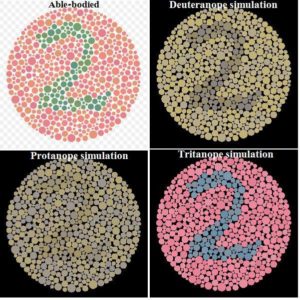Playing a game is more than just connecting your devices with a new system. It’s being part of a context that makes sense, a magical world, full of new experiences, stories, characters, and challenges.
For a game designer, it shouldn’t be different. In the book Rules of Play, the authors Salen and Zimmerman argue that the creation of meaning (and, in that case, a meaningful play) should be the goal of a successful game. So, considering this, the role of the designer is to build significant systems, that will be encountered by players and then, create experiences.
Now imagine the scenario. You’re a game designer and you have to create a game that is suitable for colour blind people. How would you proceed? And why?
First, it’s known that are lots of levels of colour blindness. People that have this problem can’t perceive the colours very well. As a designers, we could work in a palette of colours that are considered as “safe“. Or there is another process that is adding symbols to each colour, the Coloradd, that tries to translate the colours into forms. Designers can also transform their computer into a colour blind mode, using tools like ColorOracle, that create a simulation of the environment.
However, is that possible to create a colour blind mode to a game and not compromise the system?
Well, Supermagical is a game that tried to do this. Created by a japanese company called Gala Pocket, the story is about Nina (a cute witch) and her evil sisters, living in the world full of magic and colourful monsters. The mechanics of the game are a mixture of different worlds (levels) and matching colours. It seems fun, right? More than that.
Supermagical is a game full of surprises and the best one was the color blind mode. But how did they manage that? The game uses aspects of the default interface, adding icons for colour blind (as the gameplay is like “matching colours and elements”). With that, the gameplay basis is not affected.
However the experience might be still different. For players that see colours without any problem, this is just colour matching. But, for players that are colour blind, the basics are matching icons. The initiative is good, because it includes more people into the gameplay, transforming them into participants of this magical world. The aspect of “inclusion” is part of the meaningful experience. Why? Because the game can understand people’s skills and limits and can also create an environment that matches the player’s context.
This is why a meaningful gameplay should take as principle not only rules, environment, culture, structure, mechanics and design elements. It should concentrate also on the skills of the player. This is what we call as “flow”. Flow is a concept very used in games, as an aspect of success or well designed gameplay experience, when you “lose time” or “forget to eat, because it’s so immersed into the game”. What we know too is that flow it’s the relationship between challenges and skills of the player, where everything should be balanced.
So, is Supermagical a good case of games for colour blind? Let’s say that yes, it is. At some point it includes more people to the game but some aspects are still not the same (e.g. inclusion of symbols). And maybe it won’t be. Who knows? Perhaps it should be different anyway. What we can see is that this is a good case study of games that encompasses more people and this concept should be adopted by games designers in the whole world. Just because playing together is more fun!
Further reading
Why games need color blind modes – see SimCity with simulated color blindness
Flow in games
Why all designers need to understand color blindness
Tips for Designing for Colorblind Users

“Good post. I learn something new and challenging on websites I stumbleupon every day.
It will always be interesting to read through articles from other writers and use a
little something from other websites.”
Thank you very much!
“It’s not my first time to pay a quick visit this web page, i am
browsing this web page dailly and obtain pleasant information from
here all the time.”